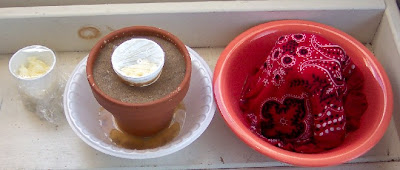The setup. Left to right: the control, Anthony's experiment (The cup of butter was kept in wet sand,) and John's experiment, (The butter was put in a bowl of water, and covered by a ceramic pot and a cloth.)
After watching The Joy of Science lecture about the Second Law of Thermodynamics, I decided to spend a week focusing on entropy. Entropy is a concept that has always interested me, although I don't understand very well. I first read about it in a short story by Thomas Pynchon, and then ran into it again when I saw Tom Stoppard's play Arcadia. But despite its interest for writers, it doesn't seem to have inspired a lot of popular science videos we could watch. The only mention I could find in the archives of what is now my favorite science show, NOVA, was a show about Absolute Zero. Luckily, this topic proved to be interesting in its own right.
The Teachers Guide for NOVA programs often contain good hands-on science activities. In this case, however, I thought the activity -- using a thermometer to calibrate a homemade thermometer -- was a tad lame. But a mention in the show about the discovery that evaporating chemicals could be used to produce refrigeration did catch my attention. I started Googling for safe classroom-type activities the kids and I could do to recreate the 1823 experiment by Michael Faraday, but perhaps without the potentially explosive chlorine.
 |
| Taking the temperature of butter in a Butter Keeper |
We looked at some different types of evaporative coolers, including a similar metallic evaporative cooler invented by a student when she was in high school. We then gathered some materials and tried making our own. Although we did get some cooling, the Butter Keeper works is most effective in hot, dry climates. Here are the directions for our experiments:
 |
| The materials. |
Materials:
- room-temperature butter (we made a bowl of butter by whipping heavy cream; you could also soften some store-bought butter)
- plastic wrap
- digital food thermometer (about $15)
- terracotta flower pots
- terracotta flower pot dishes
- disposable bowls and cups
- sand
- cloth (we used a bandana)
- water
- Fill a small disposable cup with softened butter. Cover with plastic wrap
- Use the food thermometer to punch a hole through the plastic wrap and take the temperature of the butter.
- Use the materials on hand to design and assemble a Butter Keeper that will hold the cup of butter. The Butter Keeper should hold and absorb for an extended period. See the photos for ideas.
- Place the cup of butter in the Butter Keeper. Place another cup of butter next to it as a control. Check the temperature of both cups at regular intervals to see whether the butter in the Butter Keeper is cooler than the butter sitting outside at room temperature.
What We Did:
John built one using a cloth to wick up water from a dish holding the terracotta pot. This design was apparently used in Great Britain and Australia in the 20th century.
 |
| The preparation of John's experiment. The cloth wicked the water up over the pot to keep it wet. |
 |
| John's experiment. |
 |
| The setup for Anthony's experiment. |
 |
| The sand in this experiment serves the same purpose as the cloth in John's. |

No comments:
Post a Comment